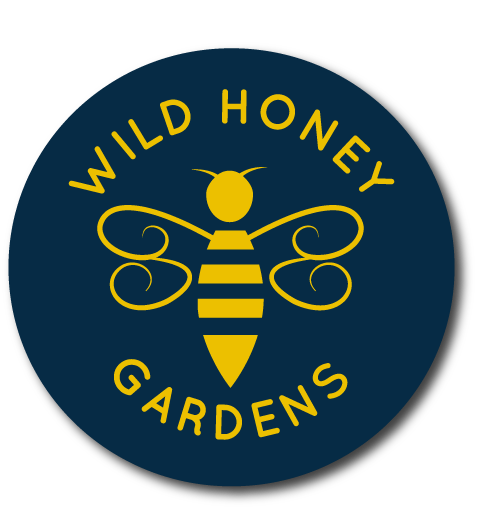POLLINATORS
When we think pollinators we think bees, and when we think bees we think honey bees, but did you know that most pollinating happens from native bees, not honey bees?
There are 4,000 different kinds of native bees that live in the U.S. alone. They come in all different sizes and colors, and they live in your yard right now! These native bees are the ones you’re hearing about when you hear that the bees are in trouble.
Plants and pollinators have it all figured out. Plants produce a sweet liquid called nectar that is attractive to insects. Insects land on these plants to take a sweet sip of nectar, and while doing so, the plants’ pollen granules stick to the insect. Then, when the insect moves on to another flower, the pollen travels with the insect and a little bit gets rubbed off on the next flower. And so it goes, minute by minute, day after day, both plants and insects benefiting from each other. Let’s give a big hurrah to ALL pollinators for a little bit and talk about some of the other pollinator heros in your yard.
4,000
varieties
of native bees live
in the United States
alone.
Hummingbirds

A hummingbird drinking nectar from a Lantana flower.

A hummingbird drinking nectar from a Horsemint flower.
Hummingbirds are great at pollinating flowers, bushes, shrubs, and trees that have trumpet shaped blooms. Their pointy beaks are perfect for poking deep down into the flowers that are hard to reach for other insects. Since hummingbirds “hover” in front of, instead of “landing” on a plant to drink from it, they can drink from the most delicate flowers and plants.
As the hummingbird goes in to sip that sweet nectar, the tacky pollen sticks to the hummingbird’s beak. As the hummingbird goes from flower to flower, getting its food needs met, it’s also meeting the flowers’ needs by pollinating the surrounding flowers with every sip. Now that’s a win-win!
Hummingbirds love plants like Trumpet Vine trees, Firecracker plants, Indian Paintbrushes, Turkscap, and Cedar Sage.
Butterflies

A butterfly drinking nectar from a Lantana flower.

A butterfly showing its curled up, tube-like tongue, also called a proboscis.
Butterflies aren’t the most beneficial pollinators, but they have their place, and we do need their help. They are more helpful to a backyard gardener than a commercial gardener, so enjoy their beauty by making your yard inviting to them! Butterflies need a secure place to land, so they prefer sturdy plants with strong stems. Because they have great eyesight, butterflies are attracted to brightly colored blossoms. They also have a great sense of smell, so flowers with delicious smelling nectar attracts more butterflies than ones that don’t.
As a butterfly walks around the surface of a flower, the sticky pollen attaches to the butterfly’s legs. This makes it easy to be transferred to the next flower as soon as the butterfly moves to the next blossom.
Native Milkweed, Parsley, Dill, Echinacea, and everything in the Aster family are great at attracting butterflies into your yard!
Moths

A moth (and a honey bee!) drinking nectar from a thistle.

A moth drinking nectar from a Horsemint flower.
Moths outnumber butterflies 10 to 1, so yay moths!
Moths are nocturnal, so you often won’t see them out pollinating in your yard. Moths are most attracted white or very pale colored flowers because they reflect the moonlight best and make them easier to see. The blossoms that moths are attracted to know this, and tend to be flowers that are more fragrant at night. Isn’t that cool!
Tonight I want you to go out and smell all your white flowers and see for yourself!
Some moths will land on the flowers they are drinking from, and other moths will hover in front of the flower and drink in mid air.
Morning Glories and Gardenias are fabulous nectar sources for moths.
Flies

A fly hanging out on a hydrangea flower.

A fly taking a rest on a daisy.
Flies. While you don’t need (and probably don’t even want) flies in your yard, they are important pollinators.
Here are a few fly facts that you may not know about:
The common house flies pollinates mango trees.
The Hoverfly pollinates carrots and avocados
Midge flies are the reason we have chocolate.
While flies aren’t major pollinators in your garden, they do land on flowers, and they do help spread pollen around your yard.
Beetles

A cute little beetle on a marigold blossom.

A beetle on a yellow daisy.
Beetles, because of their sheer numbers are a major player in the pollination game. They are attracted to bowl shaped, light colored, strongly scented flowers, and since beetles actually eat pollen, they are attracted to flowers with lots of it!
Beetles can also be considered garden pests, since they will also eat the leaves of plants, but ladybugs are considered the hero of the garden, so the beetles’ good outweighs the bad.
Wasps

A common wasp resting on a purple iris.

A Brown Paper Wasp visiting a Plumbago blossom.
Wasps are hated by most of us. We run from them and we do our best to keep them away from our homes.
Wasps don’t have hair on their bodies like bees do, so it’s harder for the pollen in a plant to stick to a wasp’s body.
Wasps need pollen and nectar to survive, so you’ll often find them in your blooming trees. In fact, all 1,000 varieties of fig trees are pollinated by wasps.
Aren’t pollinators neat? If you’d like to help invite pollinators into your yard, see my article entitled “How you can help.”
Quick Links

email: wildhoneygardens@gmail.com
Liberty Hill, TX
832.279.2972
